#the arthurian mythos is strong in the original which is why it’s strong in the remakes
Explore tagged Tumblr posts
Text
In Het Huis Anubis the Cup is literally called De Graal (aka The Grail)
cup of ankh is a reskinned holy grail. is this anything
#the arthurian mythos is strong in the original which is why it’s strong in the remakes#like the hha spin-off is literally completely arthurian#which is goofy considering King Arthur was not dutch#but like whatever it’s still fun#but yes#all of the weird myth stuff (holy grail; the sinners; and whatever else you got) is all from hha#it’s just rewritten in a diff way in hoa#no more cohesive than the OG
20 notes
·
View notes
Text
Little Witch academia theories
Since now there's the possibility of an upcoming Lwa season I thought it was the perfect time to share this theory I've had for a long time, along with what I think the upcoming season could be about, possible episode ideas and… maybe future villains. And as I’m rewatching this show , I developed this theory that I had for a long time and even came up with ideas for the new season and what it could be about.Let's speculate!!
My main theory is about Croix Meridies and how she could possibly be related to the Hanbridge family.
This might be me over analysing things, but after seeing someone on Tumblr point out to how similar Andrew and Croix's eyes are, I believe they are connected in some way, but the creators didn't have time to develop on that. Especially in how in ep 24, there was put a strong emphasis on both of their eyes. In a scene that was supposed to parallel their reactions.Especially in a show like Lwa, where all the important characters have unique eye shapes that match their personality, having two important characters have the same eye shape and the same eye color raises some questions.
And this is not the only evidence I have to Croix being related to the Hanbridge family. In episode 19, Andrew even states that him and Diana are sort of related. And now on to the Paul Hanbridge part, it would be weird for a man who claims to dislike magic so much to be related to witches. So, what if his wife was a witch, because I think there's a reason we never saw Andrew's mother, and even though we don't see all of the characters parents and flashback moments in this show, Andrew's backstory seems to be pretty important and his father is always present throughout the story.
And for a father that is so strict it raises some questions that his mother is absent. So what if his mother is… dead, and what if her death had to do something with witchcraft, possibly being a reason why Paul hates witchcraft and forced his son to have the same opinions , thinking magic is a dead practice, and his hatred seems too personal to be political in the first place.
Another interesting factor is how Paul's hatred for witches seems to be different from Blackwell's hatred for witches. Whereas Paul's reasons are more justified since he hates the art, not the artist and thinks magic and witches are outdated and have no place in the modern age, Blackwell holds this opinion out of pure bigotry.
And as much as he hates witches, Paul still tries to keep a good relation with them, even if trying to "keep his enemies in debt"

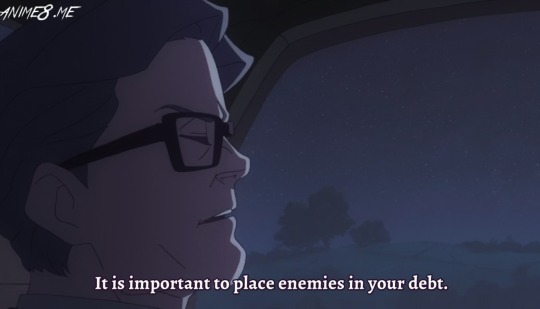
as he says in ep 6 and he seems to have had a good relation with witches and Luna Nova for a long time. So something must have happened along the way for him to hate witches and that something may involve… his wife. What if witches or witchcraft were involved in his wife's death.
And this gets us to the important part of the theory, Croix and how she could possibly be Paul's daughter. What if Andrew isn't the only child Paul has, and this theory is plausible since Croix is around 28 years old,(she graduated in 2007, the anime takes place somewhere around 2017)
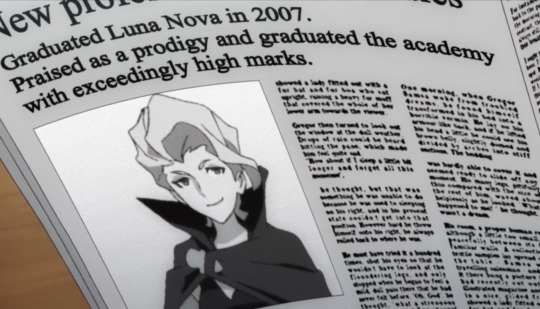

and Paul seems to be around his middle or late 50s, basically old enough to be her father. Another piece of evidence I have to that is how there not anything known about Croix's past before she joined Luna Nova, and despite her achievements and the fact that she was described as a "magic prodigy" she was also described as timid and reserved during high-school days, and back then she wasn't as confident and over the top villainous as she is today, her stance being much more distant and reserved, compared to Chariot, who was much more extroverted, even a bit of a show of, always surrounded by people.
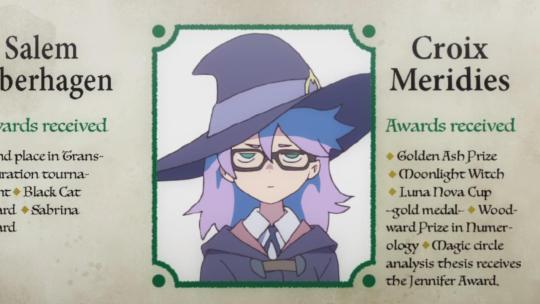

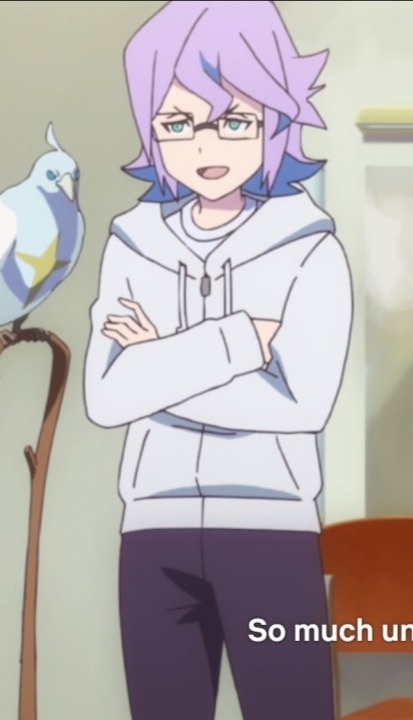
She seemed as if she was hiding from something… or someone. What if Croix ran away from home in order to pursue witchcraft, since Paul could have been just as strict about witchcraft to her as he is to Andrew.
And it would make Andrew and Paul's connection to the Chariot and Croix storyline deeper and better, since even the magic shop owner was more relevant to the plot than those two at this point, and they acted as spectators in the second half of the story. Another interesting factor is how Paul constantly says that magic is dead ,obsolete and not necessarily in modern times, while Croix's main motivation is to prove that this exact thing is wrong and that magic is still useful by fusing it with science. And think about it for a second, the damage Croix's monsters did, how Croix fueling the protests for her experiments almost sparked into ww3, all of these things affect the government, which Paul is a part of. Her villain plan might have also been a revenge plan at her father, for being an awful parental figure.
On top of that, neither Andrew or Paul ever directly interacted with Croix or even saw her, and all of the important characters saw Croix and interacted with her, except those two. And at the end of episode 25, right after Croix was arrested and left the scene, Andrew appeared, almost as if the creators didn't want the two characters to interact just yet.
And knowing that Andrew and Diana are cousins, this would also make Croix be part of the Cavendish family, Meridies being possibly a fake name she took to distance herself from both of the well known powerful families. Andrew and Diana often parallel each other in the show, and Croix and her relationship to Chariot is also supposed to be a foil to Akko and her relationship with Diana. Therefore Andrew and Croix were supposed to be a foil to each other, Croix kind of showing Andrew what can happen if he quietly held a grudge against his father and not standing up to him at the right time for two long until he eventually could snap and do the same thing as Croix. Her story of being misunderstood,missguided, filled with jealousy could serve as a cautionary tail.
And Croix being Paul’s daughter would also make sense given her overambitious personality and her constant need of validation from others , including Profesor Woodward and desire to be on top.All of these factors could have easily shaped her into the sort of person that despite having good intentions doesn't have the best ways of achieving them , often putting others in danger to do so.Her being Paul’s daughter would also make sense of why she is jealous of Chariot , since Chariot not only has the shiny rod , but also support from others and appreciation .
A reason my theory could work is how Andrew was originally supposed to be Akko’s love interest , but the creator of the show , Yoh Yoshinari scrapped that sconcept at the request of staff and voice actor , he ended up making Akko a “girl who’s not interested in boys” , so Andrew needed a new purpose in the story , and maybe him discovering Croix is his sister and potentially also becoming a wizard could be those purposes , since they already been kinda set up.
But this theory also raises some questions .How did Andrew’s mother die?Is Andrew a wizard?Did he know he had an older sister? These could be interesting themes to explore in the potential upcoming season .Other things that would be cool to see in this potential season what happened after the missile, Croix redemption arc, my theory becoming cannon and Croix and Chariot having to deal with the mistakes they made, how Akko feels about all of these, and more stuff with the nine new witches, are they considered like superheroes, are they famous now??
Now , onto what the upcoming season could potentially be about :
- As I stated in my theory , Croix and Andrew having to deal with the fact that they are siblings
-Croix redemption arc , maybe more development with her relationship with Ursula/Chariot
-Maybe another episode focused on nightfall , maybe Akko using a spell to make the Nightfall characters real for Lotte’s birthday.
-More flashbacks about Chariot and Croix’s years as Luna Nova students
-Lore behind the golden age of magic and the nine new witches
-New villains
-Return of the shiny rod , but in a unique way
-Maybe the stories could deal with Arthurian Mythos via Appleton Academy
-Male Wizards , maybe more episodes with Andrew and Frank
-More action scenes and serious moments
-The preparation for the spring festival mentioned at the end of episode 25
-More references to other pieces of media (maybe more kingsman , marvel and star wars references as well…)
I should go in depth with some of these aspects :
1.For example , even after episode 25 showed everyone cheering for the 7 witches,they were happy and cheering because otherwise the missile would have killed everyone.They now are happy that they are saved by the witches , and possibly entering a new age of magic , but what if somehow , it is discover that it was because of Croix’s magic that the missile attack almost happened in the first place.How would they react knowing a single witch was capable of such a feast.Especially how would the politicians react.Because at the end of episode 25,Paul was willing to learn more about Andrew’s opinions about witchcraft and even be open to it .But maybe after he finds out the truth about the missile attack,his hatred for witchcraft is even more reinforced , maybe ruining all the progress Andrew has been trying to make in teaching his father about magic ,for him to hate it even more now.Maybe it would even push him to become a villain in the show.
2.Another idea for a villain in the upcoming season I theorize about is Daryl , Diana’s aunt , even though she was kinda redeemed by the end of the season , she is a strange figure , possibly using dark magic , maybe after Diana became head of the Cavendish family , Daryl does not agree with some of Diana’s ways of improving the Cavendish family title and returns to villany , maybe serving as a possible introduction to dark magic (Like she literally can go through walls and has a snake as a pet AND HER EYES GLOW RED)


3.After rewatching episode 17 (Amanda O’Neill and the holy grail) I came up with this silly idea for a plotline , what if that episode wasn't just about an epic fight scene and showing us Croix’s first experiment test , but set up something even more interesting.Even if the title of the episode is a reference to “Monty Python and the Holy Grail” , in the Arturian legend of the holy grail it is Galahad the knight who is chosen to find the Holy Grail. Galahad, in both the Lancelot-Grail cycle and in Malory's retelling, is exalted above all the other knights: he is the one worthy enough to have the Holy Grail revealed to him and to be taken into Heaven , so Galahad is the one to have found the holy grail.And for a first test , Croix’s monster worked quite well , and we also know in Lwa , spirits and ghosts exist and they tend to attach themselves to objects.And if Croix’s pixels were in the grail before Louis broke it , why didn't they start working yet.My theory is that Galahad’s ghost was attached to the Holy Grail and the cubes only powered the ghost up , making it able to separate form the grail ,but decided to stay still until Louis broke the grail , pissing the ghost of Galahad off and thus punishing Louis by possessing a nearby knight armor along with Blackwell himself, combining both into a violent berserker.After Amanda destroyed the armor she could’ve weakened the ghost of Galahad , thus everything instantly went back to normal , but what if the ghost started regaining strength , adjusting to life not being attached to the grail , but planning to stroke again , to punish Louis and the other students of Appleton for ruining the reputation of the school with their hatred for witches .Appleton academy could possibly have lore connected to Arthurian legend to it , with how much they hold the importance of tradition , duels , and gentleman like behaviour , almost knight-like.Maybe the next season could have a plotline that involves stopping the Ghost of Galahad.
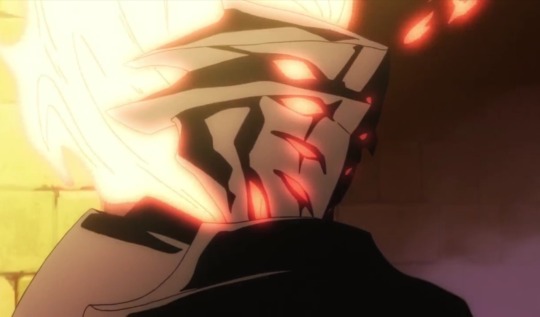
4.Last but not least , even after the shiny rod vanished in episode 25 , i think there is a way for it to return without ruining the impact it had in the show. There are seven words of arcturus , and seven of the Luna Nova students are part of the nine new witches , right ?So since the rod became a constellation at the end of the show , seven of those stars could be the seven words , so what if each of the seven words materializes as weapon of their own on earth and each of the seven witches(Akko ,Diana, Lotte,Sucy, Amanda , Constanze , Jasminka) get one of the seven words that became weapons .Because even if the rod disappeared , it came to Akko’s help in a different way , since even if the quest to bringing a new age of magic is far from complete.
#little witch academia#andrew hanbridge#Akko Kagari#Diana Cavendish#Croix Meredis#Chariot du Nord#Ursula Calistis#Little witch academia theory#Anime Theory#Anime headcanons#Lwa#Lwa theory
77 notes
·
View notes
Text
Riverdale Couples & Ships as Romantic Tropes (Part I) ❤️

In this list, I’ll be listing the Riverdale ships and couples (both teen and adult) with the romantic tropes that best represent their relationship on the show. In case you’re wondering where I got the tropes from, I got them from TVTropes.org. This list of couples and their romantic tropes is not a rankings list like my previous other lists which were rankings based on percentages. Because there are so many couples, I have decided to split the lists in two parts. Have fun reading!
#25. Archundy (Archie Andrews & Geraldine Grundy; ROMANTIC TROPE: TEACHER/STUDENT ROMANCE)



Teacher/Student Romance
"I've got it bad, got it bad, got it bad, I'm Hot For Teacher."—Van Halen
It is a pretty good bet that just about any show that features adults and teens interacting in an academic environment will eventually explore a romantic relationship between a teacher and a student. The basis for this type of relationship — if it's actually a romance and not just a Sextra Credit arrangement — can either be the adoration and respect toward the teacher and mentor figure or the teacher's protective and caring instincts, or both. The illicit, forbidden, and most often scandalous nature of these relationships can be mined for angst, and generally doesn't cause real life issues because the actors themselves are generally all above the age of consent thanks to Dawson Casting. But even if the student is eighteen or in college, this sort of extracurricular activity would still be a massive breach of professional ethics in most of the world and in some jurisdictions is considered illegal, regardless of age, in some circumstances (some teachers have been charged for relationships with high school students, even if the relationship didn't begin until after the student turned 18 and the teacher her/himself was only a few years older). Even if it was not illegal, the scandal that would erupt from this socially unacceptable affair would be so devastating it would basically cost a teacher or professor his or her job forever. There are usually different levels of moral endorsement of the relationship, depending on the genders of the participants. Relationships between male teachers and male students are condemned the most harshly. When a male teacher and a female student are together it results in the teacher being viewed as a pervert and sometimes the student being slut shamed. When it's the other way around, a female teacher with a male or even a female student is taken far less seriously. An even more outrageous double standard is that emphasis is often placed on how attractive said female teacher is — the more attractive said teacher, the more acceptable the relationship is. That said, the trope in fiction probably will involve a Hot Teacher, if only for fanservice purposes. An author might attempt to make this relationship less squicky by having the student fulfill the Wise Beyond Their Years trope, by keeping things to Courtly Love only, or by making both participants older — a graduate or doctoral student falling in love with their professor is less likely to cause moral outrage than a high school student doing the same thing due to both participants being adults, though the professional ethics of the situation remain pretty much the same. The relationship may be initiated by a Fille Fatale. A subtrope of Unequal Pairing. Compare Mrs. Robinson. See Likes Older Men, Likes Older Women, and Stacy's Mom for young people lusting after older people in general, Precocious Crush for a more innocent variant, Age-Gap Romance for when there's a significant age difference between them, and Mentor Ship. There's a version specific to magic users called Merlin and Nimue, which takes its cue from the Arthurian Mythos where Merlin formed such a pair with several women. Teacher/Parent Romance occurs when a teacher falls for their student's parent. This group of tropes is among The Oldest Ones in the Book. Although generally frowned upon in Real Life today, it's had varying levels of acceptance throughout history. It was most famously acceptable in Ancient Greece, where it took the form of Lover and Beloved.
#24. Jasolly (Jason Blossom & Polly Cooper; ROMANTIC TROPE: KISSING COUSINS)
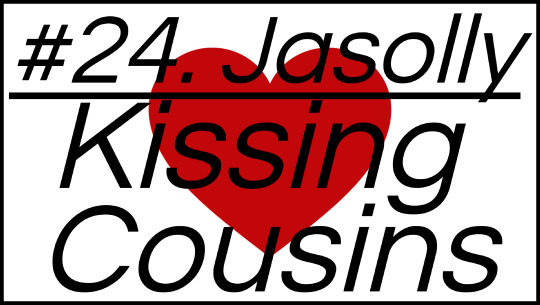


Kissing Cousins
"If you're tired of beating around the bush, why not shake the family tree? A hot cousin might fall out."—Stephen Colbert
Romantic/sexual relationships between cousins (meaning, generally, first cousins) are a phenomenon that has been more accepted in some cultures and eras than others. A great many cultures today accept it, including a majority of the industrialized world. Marrying one's extended relatives (which is technically known as clan endogamy) seems to have been common in human evolutionary history, since hominids usually lived in small nomadic bands with few available sexual partners. At the other end of the spectrum, much of the modern U.S.A. considers cousin marriage completely taboo, so Hilarity Ensues at the very mention of it. People from backwoods areas (especially the Appalachian Mountains) are often the preferred butt of many bad jokes as well as occasional bits of Self-Deprecation for the alleged prevalence of Kissing Cousins in their culture. Despite the taboo, cousin marriages are legal in about half the states in the U.S.A., though not as much in the backwoods areas and more in the modern industrialized states, the opposite of what one might expect from hearing all those jokes. Legal or not, these marriages are still not very common due to the lingering cultural taboo. All states permit marriages between second and third cousins, but even these are looked at funny. In the UK, first cousin marriage is unusual and would be regarded as rather odd, but not with the same severity as the US. Second cousin marriages and beyond would be seen as unremarkable. Expect some strong Values Dissonance between the media from the US and other countries, and between certain modern works and works from the nineteenth century and earlier, when the taboo was sometimes non-existent or even inverted. Full scholarly debate on why some cultures would forbid cousins, or even specific types of cousins, to marry, while others ignore or even encourage it, rages on, and lies beyond the scope of this wiki. According to both Oxford's and Merriam-Webster's Dictionaries, the original definition of kissing cousins was simply a relative known well enough to be given a kiss in greeting, although this meaning has long since fallen by the wayside. Check out Incest Is Relative for more closely related tropes. NOTE: This trope is for cases of actual relationships between cousins. Cousincestuous subtext goes in Incest Subtext.
#23. Joaqevin (Joaquin DeSantos & Kevin Keller; ROMANTIC TROPE: BURY YOUR GAYS)
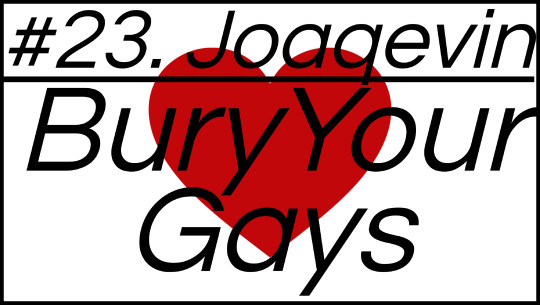

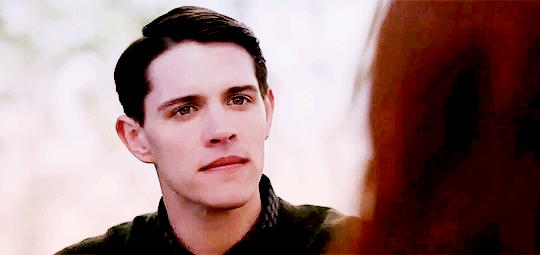
Bury Your Gays
"[Television] has yet to recover from the [2015/16 and 16/17] seasons, which included the deaths of an overwhelming number of lesbian and bisexual women characters. These deaths were often in service of another straight, cisgender character's plotline, and sent a toxic message to audiences. This decades-long trend — referred to in popular culture as "Bury Your Gays" — has made countless headlines in the past year, educating both viewers and creators alike on just how ubiquitous this trope has been."— Opening statement to the 2017/18 GLAAD (Where We Are on TV Report)
The Bury Your Gays trope in media, including all its variants, is a homophobic cliché. It is the presentation of deaths of LGBT characters where these characters are nominally able to be viewed as more expendable than their heteronormative counterparts. In this way, the death is treated as exceptional in its circumstances. Thus, it can be fairly said that, in aggregate, queer characters are more likely to die than straight characters. Indeed, it may be because they seem to have less purpose compared to straight characters, or that the supposed natural conclusion of their story is an early death. Also known as Dead Lesbian Syndrome, though that name has largely fallen out of use post-2015 and the media riots about overuse of the trope. And, as this public outcry restated, the problem isn't merely that gay characters are killed off: the problem is the tendency that gay characters are killed off in a story full of mostly straight characters, or when the characters are killed off because they are gay. However, sometimes gay characters die in fiction because, well, sometimes people die. There are many Anyone Can Die stories: barring explicit differences in the treatments of the gay and straight deaths in these, it's not odd that the gay characters are dying. The occasional death of one in a Cast Full of Gay is unlikely to be notable, either. Can be seen as Truth in Television in some cases, as gay and lesbian people are at a substantially higher risk for suicide and assault — see the tropes Gayngst-Induced Suicide and Homophobic Hate Crime. The fact that AIDS hit the gay male community most prominently provided potent fresh fuel for this long running trope (which, like many things about the eighties, still has an effect on more recent works). There may also be a higher prevalence of this trope in Period Fiction because of its supposed realism since historically there was lots of homophobic persecution — though undoubtedly plenty of acceptance, too. The exact opposite is found in Preserve Your Gays, often a reaction to this.
#22. Kevoose (Moose Mason & Kevin Keller; ROMANTIC TROPE: GAY GUY SEEKS POPULAR JOCK)

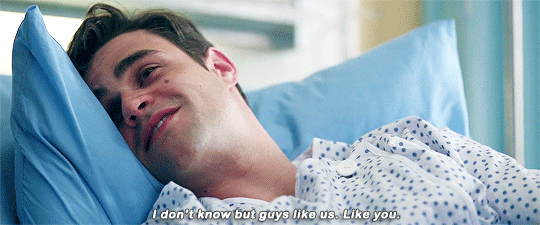
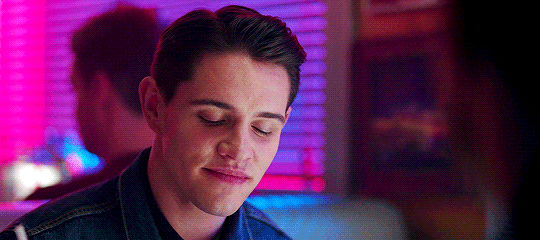
Gay Guy Seeks Popular Jock
LGBT media and LGBT characters featured in media have grown in prominence the past few decades. As the visibility grew, a common romance trope was employed over and over again enough that it became cliché: A gay teenager (who is the Audience Surrogate) ranging from Camp Gay to Adorkable to Shrinking Violet falls in love with/actively pursues/crushes on/is paired up with a popular, muscular and (usually) closeted jock. So many gay stories use this trope for several reasons, best written by Brent Hartinger, author of Geography Club.
The Star-Crossed Lovers trope is Older Than Dirt and used for so many love stories already, so it stands that it can be used for a same-sex tale of romance and woe.
Rule of Drama: The geeky gay and jock not only come from different "classes" (so to speak) but also face different hurdles in a Coming-Out Story: The geeky gay always is less conventionally masculine, so he doesn't have much to lose by being honest and open. The jock character, by contrast is a Straight Gay, and by coming out may lose a lot more, especially dropping down the social ladder which can lead to tons of conflict and obstacles for the pair getting together.
Most of these writers are gay and this trope could be construed as a form of Wish Fulfillment: The shy, awkward boy landing a popular handsome athlete is a pretty common fantasy amongst gay men, so it stands that this convention would be pretty prominent.
While a common fantasy, this trope is also Truth in Television as this kind of pairing does indeed happen in Real Life. See also Sensitive Guy and Manly Man, Masculine–Feminine Gay Couple, and Star-Crossed Lovers. Frequently employs Gayngst and the Armored Closet Gay trope. See also Single Girl Seeks Most Popular Guy and All Guys Want Cheerleaders for the heterosexual versions of this trope.
#21. McKeller (Tom Keller & Sierra McCoy; ROMANTIC TROPE: MALIGNED MIXED MARRIAGE)



Maligned Mixed Marriage
"Who can feel sympathy for Desdemona? A woman who, born and educated to a splendid and lofty station in the community, betrays her race, her sex, her duty and her country, and makes a runaway match with a blackamoor."—John Quincy Adams
A common source of conflict for a set of married protagonists (or a couple of Star-Crossed Lovers) is for the couple to be of different races among very unaccepting folks. They will be pressured to break up/divorce by family and friends and community, ostracized, exiled or forced to flee, maimed, or murdered, etc. Their children will be likewise persecuted, perhaps more so than the parents, for complicating racial relations and being inherently 'untrustworthy' due to not being fully one race or the other. Even if the adults are fine, other Kids Are Cruel after all. Expect the child to eventually pop the question about whether there's something inherently and incurably wrong with them because of their genetic heritage. And of course, sometimes it's a mixed species marriage, or one between a muggle and a mage, complete with attendant prejudice. On the plus side the scifi/fantasy elements mean the kid is likely to be The Chosen One, a Half-Human Hybrid, a Dhampyr, or perhaps even a Hybrid Monster with really cool powers. That makes up for it, right? Some examples of interracial marriages that earn disapproval can be found in Mighty Whitey and Mellow Yellow, Black Gal on White Guy Drama, and Where Da White Women At?. For mixed species marriages, see also Vampire-Werewolf Love Triangle. In Real Life, mixed-race marriages can be everything from completely accepted to something you only do if you've got a death wish. Thankfully, in many places it's skewed towards the "completely accepted" end of the spectrum, and a great way for someone to reveal themselves as a severe jackass is to show bigotry towards mixed couples. Mixed-race marriages seem to be one of the last bastions of racism. Many opponents of interracial marriage claim to oppose all other forms of racism including genocide, different legal rights, and the physical segregation of races to prevent cultural contamination (and some claim to have friends of other races). However, they generally argue that that it's cruel to have mixed-race kids because they see race as the sole/most important element of collective identity. This makes the existence of people who blur the boundaries between races distressing for people of those races, who will see their identity as being under threat and in their illogical rage target the unfortunate mixed-race children in their midst. Of course, race is just one element of collective identity and while it can be very important to some people this is by no means a given. In general, mixed-race children tend to have about the same level of trouble that their parents have — less if they look like one race or the other instead of an obvious mixture, or live in a society that doesn't care about race. In stories that take place in communities where "race" isn't a defining factor in classifying humanity (like ''some'' of the 19th century USA, East Asia, or Russia), a "mixed marriage" could mean many other different things: mixed ethnicity ("ethnicity" here being vaguely synonymous with "nationality"), mixed religion, or mixed class. Due to Values Dissonance, many of these other "mixed" marriages tend to be Dead Horse Tropes in fiction (at least in the Anglosphere), though they do surface occasionally: consider My Big Fat Greek Wedding, which mines humor from the "scandal" of a ('white') Greek-American woman choosing a ('white') Anglo-American man as her husband... a thing no longer scandalous in the late 20th century, but most certainly was just a few decades previously. Truth in Television, of course, as there are still people who feel this way. Although anti-miscegenation attitudes are not only found in the classic cases of dominant, traditional, "purity"-seeking communities. Notably, some minorities also vocalize disdain for "disloyalty", stemming from the considerable culture-driven asymmetry in cross-race relationships — a subtle but persistent visual reminder of imposed inferiority — and frustrations in changing the narrative over discomforting perceptions of hyper-attractiveness or lack thereof. Then there are some who are simply pricks. But any of these justifications can end up invoking the trope. To be clear, this trope can cover any romantic relationship, not only matrimony. We just like alliteration here.
#20. Fredary (Fred Andrews & Mary Andrews; ROMANTIC TROPE: AMICABLE EXES)



Amicable Exes
"It's things like using force together, Shouting till you're hoarse together, Getting a divorce together, That make perfect relationships."—Company ( "The Little Things You Do Together")
So, people who break up must indefinitely hate each other, right? Wrong. Increasingly common in media are situations where a divorced couple still get along for the most part, and in many cases still care about each other even though they're no longer together. In many cases the divorce happened because of distance, circumstance or the simple fact that people change rather than infidelity, betrayal or other serious problems, and the fact that they got divorced is treated as a fact of life rather than due to a flaw in the people. Both parties also generally agree that it was for the best for both of them. It's also pretty common for couples who broke up because of Incompatible Orientation or who were each other's Last Het Romance to end up this way. If there are children from the marriage they are shared without much complaint, and the amicability of the parents can often be interpreted as being partly for their sake. As such, this tends to show up in children's cartoons, perhaps as an attempt to counter the stereotype of the children of divorced parents being largely unhappy. May involve a Visit by Divorced Dad that will usually go well, and for the most part any Divorce Assets Conflicts are avoided or settled reasonably. The increase in this trope can be attributed in the dramatic shift in divorce rates and public perception of those who have gone through with divorces in the last 50 years (i.e. between the 1950s and the start of the 21st century). While divorce used to be scandalous, it's now a fairly common occurrence, and this trope reflects the view that it's just a fact of life that doesn't have to permanently poison a relationship. Sometimes it even results in Divorce Is Temporary, though this is less common in more realistic works and those aimed at children due to being a Family-Unfriendly Aesop ("wish hard enough and your parents will get back together!"). Can apply to non divorced former couples as well, thus the name. If someone's current and former squeeze get along well with each other, it's The Missus and the Ex. Compare Working with the Ex and Sex with the Ex. No, this is not about friendly .exe files.
#19. Clinelope (Clifford Blossom & Penelope Blossom; ROMANTIC TROPE: ARRANGED MARRIAGE)


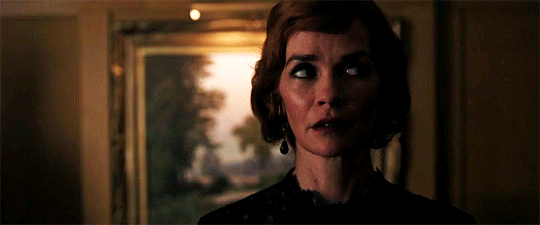
Arranged Marriage
"We who are of noble blood may not follow the wishes of our hearts."—Jane Olsen (The Cabinet of Dr. Caligari)
An Arranged Marriage is, quite simply, the idea that someone is going to choose your spouse for you. The way an Arranged Marriage is treated by the plot will be dependent on place and time. For most of human history, arranged marriages were the norm because "marriage" was less about the union of two souls and more about the union of two families. The rise of the "Marry for Love" ideal didn't really start in Western culture until the 16th century, and there are places on Earth where it still hasn't. Additionally, the "Marriage Before Romance" trope often went hand-in-hand with arranged marriages. While the priority is, again, the union of two families, that union is dependent on the stability and comfort of the two people getting married, so the two families would try their best to come up with a Perfectly Arranged Marriage. The couple's happiness just wasn't the main goal the way it is in Western marriages today. However, the one thing that is almost always present in an arranged marriage is tension. Most people don't really want to marry a total stranger (much less have sex with them), and if that total stranger turns out to be a complete rogue and a cad, it may be necessary for the heroes to spring into action and rescue the hapless member of their group who is being forced to walk down the aisle. (Of course, being Big Damn Heroes, they'll have to do so in the most overblown and dramatic way possible.) Sometimes, the person in the arranged marriage takes matters into their own hands and becomes a Runaway Fiancé. The "aggrieved" party may claim Breach of Promise of Marriage in response, as arranged marriages tend to be viewed as legally binding commitments by those who initiate it. Alternately, there's a Love Triangle. The character of the suitor is less likely to be important in those cases, but they generally won't look kindly on the outsider's interference. Conversely, an Arranged Marriage can be used to lock the hero and heroine together so that their disputes can not end with one of them washing their hands of the other. A common tactic is for the daughter of a wealthy but common family to be matched with the Impoverished Patrician, for his title: Nobility Marries Money. Occasionally, it's the other way around, with a titled daughter and a moneyed son. Families may even pledge infant children in marriage pacts that cannot be concluded until many years later. Both in fiction and in Real Life, royal children (sons as well as daughters) were used as pawns in the political game cementing alliances and peace treaties with their marriages. You might say it was their job to take part in such Altar Diplomacy. The Arranged Marriage is not to be confused with: a Childhood Marriage Promise (whereby a prepubescent couple voluntarily pledges their own non-legally-binding, future troth); a marriage which may arise out of convenience; or a marriage that arises from some kind of cultural mistake. For clarity's sake, the Arranged Marriage trope will deal only with more binding, traditional types of unions. See also Parental Marriage Veto, You Have Waited Long Enough, Old Man Marrying a Child, Homosocial Heterosexuality, Royal Inbreeding, and Marriage Before Romance. A Shotgun Wedding is a short-notice forced marriage. If someone agrees to an Arranged Marriage but loves someone else, Courtly Love may be involved. If the people doing the "arranging" in the marriage aren't the parents, that's a Bureaucratically Arranged Marriage. Often involves Prince Charmless and Rebellious Princess. At least recently, one of the potential spouses was as likely as not to try to defy this. When the audience really doesn't want this marriage, expect the Big Damn Heroes to show up right at the Speak Now or Forever Hold Your Peace line. To see the types of follies and foibles associated with modern dating services, see Dating Service Disaster. Supertrope to Perfectly Arranged Marriage. Subtrope of Marriage of Convenience. Contrast Marry for Love. Compare And Now You Must Marry Me. Compare and contrast Fourth Date Marriage, where the couple likewise barely knows each other but it was Love at First Sight.
#18. Halice (Hal Cooper & Alice Cooper; ROMANTIC TROPE: AWFUL WEDDED LIFE)



Awful Wedded Life
Take it from me Spaghetti Man, better dead than wed."— Richie Tozier, IT
The depiction of monogamous marriage as rather like a long, slow, exquisite torture by a sadistic god from whose malicious clutches escape is impossible. Husbands are child-like buffoons who watch too much football, leave the toilet seat up, ogle hot women, and forget anniversaries. Wives are frigid, nagging, hateful shrews with zero interest in sex. Children destroy your home and what little peace of mind you have left, while waiting their turn to perpetuate the cycle. Obnoxious In-Laws serve to add to the misery. The audience may be left wondering, "Why don't they just get a divorce, if they're so miserable?" Married... with Children was probably the first time this trope was the main focus of an American sitcom, but it's been a mainstay of British shows since The '50s. It is also a staple of Borscht Belthumour, but that may be less to do with venom than with Jews Love to Argue or Jewish Complaining. The name, for those who don't get it, is a reference to the line of the traditional wedding vows, "Lawful wedded wife". Similar to No Accounting for Taste, but you'll rarely (if ever) see the Aww, Look! They Really Do Love Each Other moments occasionally found in that trope. Compare The Masochism Tango, Belligerent Sexual Tension, Like an Old Married Couple, Dead Sparks, and Married Too Young. Contrast Happily Married for the opposite and Happy Marriage Charade for when this trope pretends to be Happily Married. Unfortunately, Truth in Television for many people until quite recently, in eras with some combination of marriages being arranged for family advantage (or some other type of Marriage of Convenience) rather than created by mutual attraction, divorce being impossible or hugely disapproved of, or unintentional pregnancy leading to a choice of marriage or social ostracism.
#17. Fralice (Fred Andrews & Alice Cooper; ROMANTIC TROPE: AW, LOOK! THEY REALLY DO LOVE EACH OTHER)


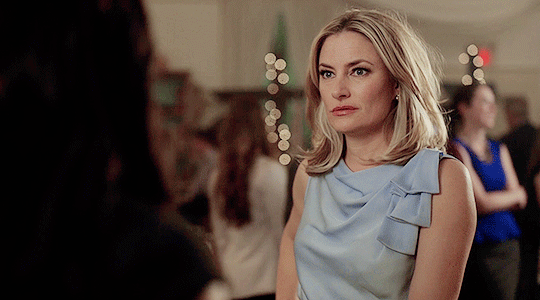
Aw, Look! They Really Do Love Each Other
When a couple/potential couple — who spend the entirety of the show yelling at each other, insulting one another, stabbing each other in the back, etc. — have a moment when they reveal that, deep down, they really care for one another. Awwww. Often takes place in a humorous rushing-to-your-spouse's-defense manner, where one of them angrily defends the other against the same kind of insults that they themselves like to dish out. The common line is: "Nobody insults/beats up/threatens my wife, husband, boyfriend, girlfriend but me!" If this relation is between friends then they are Vitriolic Best Buds. If it is between siblings, then it either combines Big Brother Bully and Big Brother Instinct or is Thicker Than Water. If the romance part comes without warning or justification, the trope may fall flat, since it comes out of nowhere when the previous context of the story makes it seem like they have nothing to love about each other. When couples don't even have these moments you get No Accounting for Taste. See also Defrosting Ice Queen, Slap-Slap-Kiss and Belligerent Sexual Tension. A couple version of a Pet the Dog moment.
#16. Halelope (Hal Cooper & Penelope Blossom; ROMANTIC TROPE: YOUR CHEATING HEART)


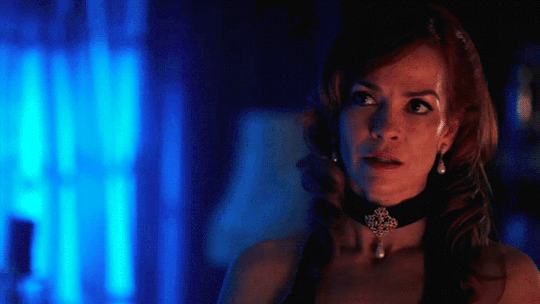
Your Cheating Heart
"Your cheatin' heart will make you weep, You'll cry and cry and try to sleep. But sleep won't come the whole night through, Your cheatin' heart will tell on you."—Hank Williams ( "Your Cheatin' Heart”)
Two-timing, playing away from home, having a bit on the side, going behind your partner's back, adultery, infidelity... There are a lot of names for cheating on your partner, but most of them have the same outcome: a world of hurt. Most of us recognize this type of plot: Bob is married to Alice. One day, Bob sees Carol at a club and is attracted to her. Perhaps things haven't been going so well with Alice for some time. Maybe they just had a major fight and Bob stormed off. Or maybe his marriage is perfectly healthy, and Bob has no excuse. Whatever the reason, Bob flirts with Carol, which eventually leads to a sexual or romantic relationship and the various things that entails. But here's the thing: Bob doesn't tell Alice about it. He doesn't dump her, he doesn't tell her that he thinks the marriage is on the rocks, he doesn't talk to her about Polyamory or swinging, he doesn't even ask for "more space". He continues to play the part of her husband, and expects her to continue being his wife, hoping that Alice won't notice when he starts coming in late for dinner, or ask him about the mysterious expenditures on their joint account. Sometimes, just to really play Alice for a sucker, their marriage will seemingly improve— he buys Alice gifts, pays attention to her and seems much happier, but all the while he's running off to see Carol. For extra scumbag points, he may be keeping Carol similarly in the dark about Alice. Chances are he'll eventually get caught; if he didn't, the story wouldn't have the same dramatic impact. A lot of angst and tension will ensue. Way back in the day, when marriage was considered permanent and divorce was a word whispered fearfully by gossiping old ladies, The Affair was a shocker of a storyline, and very often an automatic Moral Event Horizon for the cheating partner. However, it's worth noting that even further back in the day, the gods, goddesses and minor side characters of mythology listed "infidelity" under "Hobbies", didn't particularly care if their new "partner" was willing, and got away with it. Only their mortal lovers got the nasty side of the wronged wife's/husband's temper when the affair was discovered. Nowadays, affairs are common in any Soap Opera and turn up an awful lot in other types of story as well. We don't really expect a fictional husband and wife to stay faithful to each other for forty or so years. Supposedly, a solid marriage makes a boring story (though some would disagree). Often, a sequence of "get together → one cheats → they break up → they make up → the other one cheats", and so on) will be followed so often and so tiresomely that it becomes a Yoyo Plot Point. What defines cheating usually depends on the context of the story and the characters involved. Stories aimed at younger audiences, or with a clear emphasis on romantic, monogamous relationships, will probably count kissing and flirting as cheating. Most examples of cheating in shows aimed at adults, however, will involve sex. Occasionally, characters may clash specifically because they have different definitions of cheating: for example, the husband who protests that he was drunk and it was "just a kiss" to his furious wife, or a girlfriend who can't understand why her boyfriend doesn't like her flirting with her male friends. A few rules usually hold true in fiction: If a woman cheats, her paramour just scored a massive victory over her cuckolded husband, who is now permanently dishonored. The (male) big boss of any given workplace is likely to be two-timing his wife. The Protagonist remains sympathetic if they cheat, and becomes an innocent, wronged victim if they are the one being cheated on. Bisexuals are portrayed as incapable of faithfulness or have merely informed sexuality, and men are more prone to having affairs than women (and often portrayed as The Unfair Sex too when it comes to cheating). Unfortunately, adultery is Truth in Television, as many broken hearts and broken families will testify. It is also one of the most common reasons that people murder each other.
#15. Fladys (FP Jones & Gladys Jones; ROMANTIC TROPE: OUTLAW COUPLE)
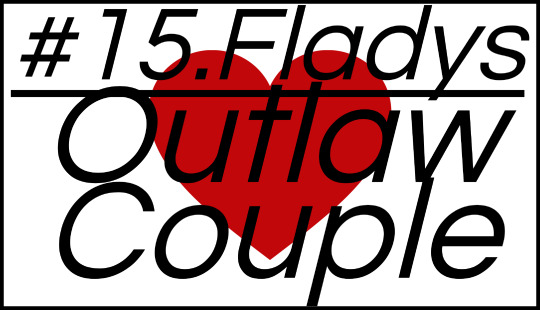


Outlaw Couple
Two lovers who team up to commit crime, usually violent crime and especially robbery, and are usually on the run from the law. Such couples are almost always inspired by Bonnie Parker and Clyde Barrow, "Bonnie & Clyde." Which one is the brains of the outfit tends to vary from couple to couple. Sometimes one is a calm and collected criminal who charms the other into a life of crime. Other times, one is a loose cannon while the other is a cool-headed professional. Many Bonnie and Clyde stories end in tragedy, as did the original couple. This one is Truth in Television, though it should be noted that most fiction tends to romanticize the life of crime that such characters tend to lead. Compare/contrast Minion Shipping. See Unholy Matrimony for a more over-the-top, super powered version of this team-up. Expect some Back-to-Back Badasses moments, as well as a selfish suicide if one partner dies. May result in sympathetic villains or even Sympathetic Murderers, especially if their affection for each other is given the spotlight.
#14. Hiramione (Hiram Lodge & Hermione Lodge; ROMANTIC TROPE: UNHOLY MATRIMONY)
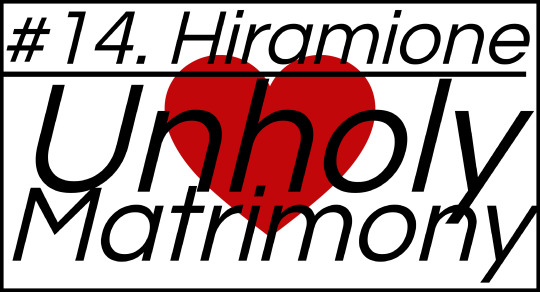


Unholy Matrimony
Poison Ivy: Once you have frozen mankind, these babies will overrun the globe, and we shall rule them, for we will be the only two people left in the world. Mr. Freeze: Adam and Evil.—Batman & Robin
You know how the story goes, right? Big Bad meets Baroness, Baroness meets Big Bad, their eyes meet, and horribly discordant music that sounds not unlike the screaming of tortured souls arise. It's black magic... a match made in hell! Lord Worldbreaker and Lady Firestorm are, individually, serious threats to the heroes, but what happens if they're suddenly working intimately together? That's when it gets really dangerous. A pair of villains capable of channeling The Power of Love is enough to give even the most hardened group of heroes a serious challenge, and worse yet, seeing the villains in love may make them doubt their own motivations. Should one of the villains fall, the other one grieving over their fallen lover is quite likely to initialize an Alas, Poor Villainscenario, and maybe even a My God, What Have I Done? Should another villain start messing with the happy couple, it's usually played as a Kick the Dog moment. ...of course, these people are villains, so you can never really be sure that one or both of them isn't just playing at being in love, in order to manipulate and use the other. If the love is genuine but unrequited, expect the one who genuinely loves to sacrifice their life to protect the other, only for the other to disdainfully ignore them as they lie dying, proclaiming that they're no longer useful. Usually, this signals a crossing of the Moral Event Horizon. If both were faking it, expect them to show their true colors at the same time. Hilarity Ensues—and it's never mentioned ever again. The most classic version of this trope occurs when two previously established antagonists suddenly take a new-found interest in each other, but it can also involve a newcomer falling for an established villain, or even a pair of villains who were, from the beginning, a "villainous couple". In the first-mentioned scenario, Enemy Mine may occur in order to match the united power of the couple — which can get particularly interesting if the "bedfellow" is another villain, who is driven by jealousy...May form a Big Bad Duumvirate. Compare Villainous Friendship, when the two are truly friends with each other, but not in a romantic way. Contrast Minion Shipping (which involves minions instead of actual villains) and Mad Love (which is one-sided). Outlaw Couple is the petty crime version of this. In the case of fiction with multiple villains where taking two out of the equation would still leave a bunch of bad guys, if it's genuine on both sides this can be used as a prelude to a Heel–Face Turn or at the very least a "Get out of Jail Free" Card. If the couple in question is heterosexual, expect the man to be the more important half of the couple, possibly making her more of a Dark Mistress. Subtrope of Even Evil Has Loved Ones. Not to be confused with Awful Wedded Life, which describes the marriage itself to be terrible, not the people involved.
#13. Formione (FP Jones & Hermione Lodge; ROMANTIC TROPE: WELL, EXCUSE ME, PRINCESS! & FOE ROMANCE SUBTEXT)
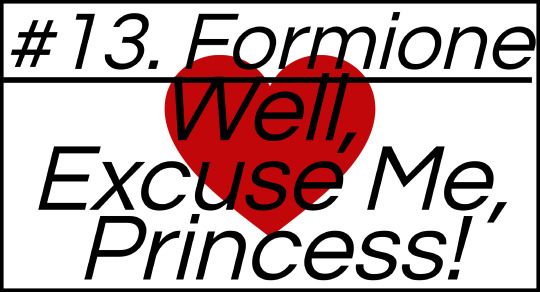

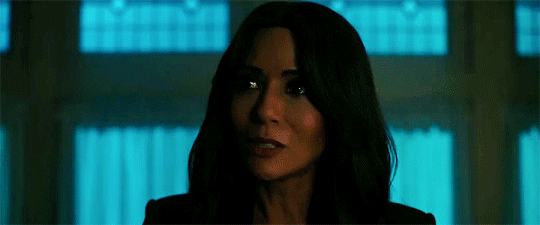
Well, Excuse Me, Princess!
"Why must everything you say to me sound like a criticism?"— Robin Hood to Marian (BBC's Robin Hood)
Snarky loser hero meets snarky haughty heroine. They either fall in love, or they snark. Usually both. This is essentially a satire of the standard Magical Girlfriend, which describes a beautiful, classy, good-mannered, loyal girl—the logical result being she should be somewhat critical of her loser boyfriend. She makes no attempt to ignore the fact that he is the Loser Protagonist, and frequently calls him on it, criticizes him, and rarely if ever fawns over him like some Fangirl. She expects better from him and pushes him to improve, while still expecting to be taken care of. However, the guy usually takes it in stride, mocks her in return, or just says the trope title. Expect a generous helping of Aww, Look! They Really Do Love Each Other moments, to let the audience know why they should be supporting this couple. The idea is that the snarky loser will help the princess loosen up and be friendlier, while the princess constantly holding the loser to a higher standard will eventually make him improve himself. Often appears in Love Comedies, depending on how satirical the story is. See also Tsundere. Related to Belligerent Sexual Tension. Compare/Contrast Screw You, Elves! and Surrounded by Idiots. If it involves an actual Princess Princess, see Royal Brat. The Woman Wearing the Queenly Mask can make similar demands.
Foe Romance Subtext
"Thou hast beat me out Twelve several times, and I have nightly since Dreamt of encounters 'twixt thyself and me; We have been down together in my sleep, Unbuckling helms, fisting each other's throat, And waked half dead with nothing."— Aufidius to his blood enemy, Act 4, Scene 5, Coriolanus
The implications of sexual tension between arch-enemies. Just as Ho Yay is about the situation of implying romance where even the characters' canonical sexual orientations make it implausible, this trope intentionally creates an even deeper paradox by subtextually implying love in a relationship that is, textually, the opposite of love. This trope is much more likely to come into play if one is The Rival and The Only One Allowed to Defeat You, or a Rival Turned Evil, and is especially likely if one is an Evil Former Friend. If enemies have to work together, it can give the impression that adversity makes strange bedfellows. Other times, this trope can be invoked by a villain who seems to be too eager and persistent about trying to convince or force the hero to rule the world together, and eventually appear as a one-sided Villainous Crush. Terms of Endangerment often feature, and watch out for the "Take That!" Kiss. Dark Magical Girls are often depicted as understanding their Magical Girl counterpart far more than anyone else, and after inevitable redemption at the very least become Heterosexual Life-Partners, if not more. Since most heroes and their villains tend to be the same gender, this results in most examples of Foe Yay overlapping with Ho Yay, but different gender foes qualify too. When it ultimately goes from subtext to text, and the two admit that they love each other, it is called Dating Catwoman. Contrast with Defecting for Love. For the villain who really is sexually obsessed with The Hero, see Stalker with a Crush, Mind Game Ship, In Love with Your Carnage, and Villainous Crush. See also Destructo-Nookie, when they actually do go the whole nine yards. See also Foe Yay Shipping, for the subjective audience reaction of insisting that after a certain number of such scenes, the two should become a couple (this appeal often lies in the forbidden nature of the relationship, a staple of the shipper diet). Please move non-objective examples to that page. Not to be confused with Faux Yay.
#12. Fredmione (Fred Andrews & Hermione Lodge; ROMANTIC TROPE: RICH SUITOR, POOR SUITOR)



Rich Suitor, Poor Suitor
"One of them is dark and poor One fair with lots of money I don't know which one to choose The flower or the honey"—Celtic Woman ("At the Ceili")
One of the most common complications in the classic Love Triangle scenario. Two men are vying for a women's affection. Who's the right one? It's hard to tell, but there's a good chance that one of them is considerably wealthier than the other, and he can provide security, glamour and the good life, while the other (who has a good chance of being an impoverished artist) can give none of the same. What are you gonna do? Most of the time, it's going to be "go with the poor one," and the story will carry an Aesop that true love is worth more than material wealth. This makes sense if the rich one is a total bore or outright jackass, or the woman is just not in love with him as she is with the broke one. When done poorly, the rich one often ends up as the Designated Villain. This trope overlaps considerably with Wrong Guy First and Disposable Fiancé, but keep in mind that the rich suitor is not necessarily wrong, first or particularly disposable. This trope is most often "two men and one women" because of a sense that woman needs someone to 'provide for her'. This sort of logic ties into Unable to Support a Wife and generates part of this trope's conflict. If the suitors are also a Betty and Veronica pair, the dynamic will typically be either "poor but nice suitor vs. rich but haughty suitor" or "poor but exciting suitor vs. rich but boring suitor", being obviously slanted toward the poor suitor in both cases. In fact, having the rich suitor win or even be a decent, likeable person is a rare variation of this trope.note Perhaps the trope name should have been "Poor Suitor Wins" instead? The odd exception can happen though, with the rich suitor being a nice, decent person and the poor suitor being a male Gold Digger. Compare Gold Digger, Meal Ticket, and Uptown Girl. It can involve Compete for the Maiden's Hand.
End of Part I. Please check out Part II!
#varchie#jeronica#bughead#choni#falice#barchie#veggie#archosie#jarchie#beronica#cheronica#riverdale#gifs not mine
17 notes
·
View notes
Text
Not Exactly T.H. White
by Viorica
Wednesday, 14 January 2009
Viorica's review of the BBC's cracktastic Merlin.~
After what might be called a bitter breakup with BBC’s Robin Hood, I promised myself that I’d avoid any further TV shows that were more enjoyable for their badness than their quality. So when the majority of my Livejournal friendslist began squeeing over Merlin, I swore I’d avoid the temptation. No matter how shiny and cracky and homoerotic it appeared, I was not going to watch it, because I knew that if I did I’d be sucked into shiny-cracky-homoerotic-bad TV land. But eventually the temptation grew too strong, and I downloaded the first season to watch over Christmas break. I expected bad special effects; I got that. I expected inaccuracy; I got that in droves. I expected mediocre writing and acting, and I got . . . something else.
If you assumed from the title of the show that Merlin is based on Arthurian legends, you’d be better off abandoning that idea right now. The series revolves around a teenage boy named - you guessed it - Merlin who is sent to live at the court of Camelot by his mother, because he’s manifested magical powers, and she has an old friend, Gaius who lives at Camelot and who is better equipped to train Merlin than she is. Unfortunately for Merlin, magic is outlawed in Camelot, and has been since the birth of Prince Arthur about twenty years earlier. Yes, Merlin and Arthur and the same age, and that’s only the beginning of the divergence from the original stories. Merlin manages to land a job as Arthur’s manservant, much to Arthur’s chagrin, as Merlin has a tendency to call Arthur out on his bullshit. From there on in, it’s up to Merlin to protect Arthur from various pissed-off sorcerers (Arthur’s father Uther Pendragon has ordered all magic-users burned at the stake, which has naturally rubbed them up the wrong way) while simultaneously trying to hide his own powers and protect innocent people from Uther’s wrath. He’s helped by Guinevere, aka Gwen, a maid at the castle, and her mistress Morgana, Uther’s ward, who disagrees with his policies. Merlin is also mentored by a dragon being held prisoner under the castle, who has an irritating tendency to intone “Protecting Arthur is your destiny, Merlin!” at least once an episode.
If you think it sounds cheesy, you’re completely right. It’s intended as a kid’s show, and filmed with the audience in mind - despite the rather high amounts of violence (at least one person dies per episode) the camera always cuts away from the nasty stuff. The main conflict is Merlin’s need to hide the fact that he has magical powers, and the fact that this keeps conflicting with his need to protect Arthur, which obviously has no basis whatsoever in Arthurian legend, but then neither does anything else. As the series progresses, Arthur and Merlin’s relationship evolves from that of mutual resentment to comfortable partnership, and eventually friendship (which comes off as very, very very homoerotic, probably due to the fact that it involves a lot of hugging and acts of unwavering devotion. The cynical part of me thinks that the writers are playing to the crowd.) The actors playing Merlin and Arthur are actually quite good, and what they bring to their roles - quiet goodness in Colin Morgan’s case and brash testosterone in Bradley James’s - helps establish the boys as genuinely likeable people, struggling to figure out their place in the world. Angel Coulby is incredibly sweet as shy, blushing Gwen, who spends most of her time trying to make everyone as happy as possible. The weak link in the cast is Katie McGrath, who plays Morgana with a maximum of two facial expressions: smug and perturbed. The older actors are obviously having fun with their roles, and bringing some gravitas to the characters as well - Anthony Stewart Head’s Uther is unlikeable by virtue of his actions (this is, after all, a man who ordered all magicians put to death over a mistake he made) but thanks to Stewart Head’s talent, you can see a bit of humanity shining through from behind the throne. Richard Wilson’s Gaius is your standard mentor/father figure, with a dry sense of humour that managed to make me laugh at least once an episode. John Hurt voiced the Dragon, and there really isn’t much to say about his performance - given the fact that all he gets to do is blather about destiny, there isn’t much room to stretch. The guest stars are touch-and-go - Santiago Cabrera, who played Lancelot, was absolutely awful, while Asa Butterfield was suitably creepy as an eight-year-old Mordred. No one is giving Lawrence Olivier a run for his money, but they’re a very talented bunch, especially considering that most of them haven’t hit thirty yet.
I’m not entirely sure what I expected from the writing. Before watching it, I’d heard the show referred to “crappy tweenager fantasy” so I assumed it’d be a lot of rambling about Destiny and True Love and The Power of Friendship. While that is included (see my note on the Dragon of Destiny) it’s not as wearing as you might expect, mostly because the characters point out the stupidity of doing something because it’s My Destiny at least once an episode. No one wants to watch a show about people who do things because they’re told; most of the struggles come from Merlin and his friends struggling with the expectations they’re being held up to versus their own inherent sense of what’s right. My personal favourite episode revolves around a young boy who Uther wants to execute because he’s a Druid-in-training. Merlin, who obviously takes the stance that killing innocent children is wrong, enlists Morgana’s help to hide the boy, and Arthur’s to smuggle him out of Camelot. For this he is repeatedly chastised by the Dragon, because the boy is eventually going to kill Arthur. Merlin and co say “Screw this” and smuggle the boy away to his own people. At the end of the episode (spoilers, obviously) Arthur asks for his name, and the child replies “Mordred.” It’s a deliciously eerie moment (helped out by Mordred’s creepy stare) and an interesting message about Destiny v. Free Will: the choices of Merlin and his friends will make or break Camelot, but it’s up to them to decide what it’s worth. Fortunately, not all of the destiny-related storylines are that gloomy. For example, one of the show’s most endearing points is the relationship between Merlin and Arthur, which begins with Merlin flat-out chastising Arthur for taunting a servant. Although Merlin is repeatedly pushed towards the prince by the dragon (for this reason, he’s acquired the fandom nickname “Slash Dragon”) their relationship eventually becomes that of friends. When Merlin goes to protect Arthur at the potential expense of his own life, he’s doing it out of affection for the prince rather than a sense of duty, and that - the inherent nobility of the main cast - is a big part of what makes the show so endearing.
There is, of course, the problem of the show’s title, which I’ll have to address or risk this article becoming unadulterated gushing. I’m not especially familiar with Arthurian legend - I know the basics, and I’m about thirty pages into The Once and Future King, but I’m far from an expert - but from what I do know, I honestly can’t understand why they decided to tack the name “Merlin” on it at all. There are references to “canon”, such as it is - in one episode, Arthur is wounded by the Questing Beast - but overall, it plays out like an original story with occasional allusions to Thomas Malory or T.H. White. As I’ve said, it’s good enough to stand on its own, and I think the attempts at labelling it an Arthurian adaptation are going to be detrimental in the long run. Instead of being remembered as a well-written original series, it’s going to end up being dismissed as “that crappy Arthurian adaptation that screwed up the stories”. Actually, the fact that they felt the need to try and slap the name of a pre-existing story on it kind of makes me sad, because it implies that they felt they couldn’t market an original series, and that’s just depressing. Aside from the rage-inducing potential for Arthurian enthusiasts, there’s some holes in the writing - in one episode Morgana says that Gaius has been caring for her since before she can remember, then later claims that she came to live in Camelot when she was ten, implying either than she has long-term memory loss or that someone didn’t proofread closely enough. Still, the small slipups aren’t enough to detract from a genuinely enjoyable show. And if all else fails, you can always hit mute and enjoy the eye candy.Themes:
TV & Movies
~
bookmark this with - facebook - delicious - digg - stumbleupon - reddit
~Comments (
go to latest
)
Wardog
at 10:16 on 2009-01-14Hello, welcome - and thank you for this wonderful review. I no longer need feel ashamed of my secret love for Merlin. When it first came on, I dismissed it after about 10 ten minutes (Uther's first 'by the way, this is the backplot' speech didn't help) but a few weeks later my LJ friendslist also exploded with squee and joy, so I gave it another go and, lo, it was simultaneously awesome and awful and utterly utterly watchable.
You're absolutely right about Morganna not being quite up to speed on, y'know, this 'acting' thing ... but she is very, very beautiful, so I don't mind. And the dragon is a bit repetative, despite being voiced by John Hurt.
The weird thing is I don't really get any slashy kind of vibe from Arthur and Merlin, despite the fact that these two boys finding friendship and making sacrifices for each other ought to be very homoerotic. I suppose I find it slashy in principle but there isn't much a spark between the actors (I mean in terms of teh gay) to make it stick. Possibly I am just missing.
As you say in your conclusion I do find Merlin's status as an adaption interesting - I actually rather enjoyed the complete lack of respect with which they treated the mythos, once I got over myself about it. The Arthurian background does give it all a familiarity and a resonance that might have been lacking if it was just Generic Fantasy Story About Friendship and Valour. Although it is a bit dodgy I have come to think the Arthurian dimension does add something - there's always something joyous about watching people play in the paddling pool of literature and start a water fight.
permalink
-
go to top
Rami
at 10:49 on 2009-01-14Yay! I somewhat guiltily enjoyed Merlin myself, including the not-quite-aside allusions to actual canon / legend (the court genealogist appears to be Geoffrey of Monmouth ;-)). Arthurian legend, historically, has been pretty flexible and as far as I know there isn't any real canon — so I'm all in favor of going in a new direction with it, and I'm quite willing to forgive the writers for taking advantage of all the gravitas and popular awareness that Arthur's story gives you. As you said, that moment when the little Druid boy tells Arthur his name is eerie -- but it would have been meaningless if it hadn't been Mordred talking to Arthur, and / or you didn't know who Mordred and Arthur were.
About the cast — Anthony Head and Richard Wilson are brilliant, of course, I can't disagree, but I have to admit I don't share your reservations about Katie McGrath. (But maybe that's because of the eye-candy factor.)
Perhaps it's my lack of slash goggles but I don't see the "very, very homoerotic" between Merlin and Arthur? I wonder if it's just 21st-century cynicism that makes "heartfelt and sincere" have to mean "Twu Wuv"?
permalink
-
go to top
Rami
at 10:52 on 2009-01-14Oh God Kyra and I have just posted very nearly the same comment.
Resistance is futile
I mean, no, FerretBrain doesn't have a "Collective Consciousness" feature...
permalink
-
go to top
Wardog
at 12:06 on 2009-01-14You will be assimilated....
permalink
-
go to top
Viorica
at 22:18 on 2009-01-14I suppose the slash question depends on what you go in expecting. I was told repeatedly before ever watching it that the boys were the slashiest slashy things that were ever slashed, so I went in with slash goggles firmly strapped on. And I suppose there's an interesting study to be done on the way men show affection v. the way women do and how it's interpreted by outside observers . . . but as far as fandom's concernd, it's all about the pretty and the gay.
As for Katie McGrath, she is pretty, but there's always this irritating feeling that I'd like the character so much more if she could emote properly. As it is, she tends to grate.
Apropos of nothing, have you watched the video diaries? They're screamingly hilarious, and both Bradley James and Colin Morgan act uncannily like their characters. It's a little creepy . . .
permalink
-
go to top
Wardog
at 11:35 on 2009-01-15That's the thing, although I'm not a slasher myself, I do occasionally find myself on the outskirts of fandom enough to have some slash goggles of my own. I was prepared for slash, I looked for slash, I saw ... the motions of slash ... but I didn't *feel* the slash. Sometimes there's a genuine spark between actors or something about the way a relationship is portrayed that makes me secretly believe something could conceivably be going on between them. I was re-watching DS9 (sad bastard that I am) recently and, despite knowing not a damn thing about the DS9 fandom, I became immediately and increasingly convinced that Sisko and Dukat were having incredibly hot hatesex... (Dan holds out for Dax/Kira girlsex, however, - they are certainly very giggly together).
I watched some of the video diaries - Bradley James is so adorably silly. I mean this in a maternal way, not a sick way. I particularly liked his musing on the cockatrice.
By the way, I meant to ask, what caused things to sour with Robin Hood? I never watched it so...
permalink
-
go to top
Gina Dhawa
at 16:04 on 2009-01-16
Arthurian legend, historically, has been pretty flexible and as far as I know there isn't any real canon — so I'm all in favor of going in a new direction with it ... that moment when the little Druid boy tells Arthur his name is eerie -- but it would have been meaningless if it hadn't been Mordred talking to Arthur, and / or you didn't know who Mordred and Arthur were.
This is my justification for liking
Merlin
the way it is. T.H. White took some pretty big liberties along the way (though if you're thirty pages in, I won't spoil that), as have any of the people who have written the story down over the years. The trouble is convincing people there's not really a canon to be followed, that if you take the earliest versions of the stories and put them to what you might find in a modern collection, there are so many differences that you might think you weren't reading the same story at all.
permalink
-
go to top
Viorica
at 19:51 on 2009-01-16Well, it could be argued that there are some basic plot foundations- Merlin being Arthur's mentor, Guinevere as his wife (though they still have time to do that), Morgana being his half-sister, etc. I think the reason some people don't like it is because they grew up on "The Sword and the Stone", so the show is effectively stomping on their childhood memories. I don't have any such memories to get stomped on, so it doesn't bug me.
Re: Robin Hood. It started out as silly fun, but it as it went on, you realized that the people running the show didn't know or care what they were doing. There were no efforts at making the costumes or scenery look nice, and virtually none of the characters were likeable, or even tolerable. Their Robin is the kind of guy who whines at an ex-girlfriend for "betraying" him when she's forced into marriage with another man. The urge to punch the title character in the face was stronger than any desire to keep watching.
permalink
-
go to top
Sonia Mitchell
at 22:16 on 2009-01-16Great article. I didn't catch all the episodes, but definitely enjoyed the ones I did see. I like your point about the gravitas the older actors bring, particularly Head (in what could have been a pretty thankless role given his character's lack of humour).
Interesting discussion about the appropriate amount of reverence for the source material, too. I quite like the way Merlin did it, with plenty there for people who do know a bit about Arthurian legend but not so much you know for sure what's going to happen. I never saw Smallville, but I think of Merlin in much the same way - you know what happens down the line, but these are the gaps in between. And knowing what lies ahead is an interesting experience, because you're watching for it and everyone involved in the show knows you are (of the ones I saw, Lancelot's episode was the most willing to play with this).
It's also pretty dangerous, of course, because unless they're willing to go down the rejected destiny road the main young characters all have to live. I think they've got a nice balance - there's plenty of peril, but the real danger is more often disgrace than death (though I missed the last few episodes, so for all I know there was a dramatic and bloody finale).
permalink
-
go to top
Viorica
at 01:30 on 2009-01-17There was *almost* a dramatic and bloody finale, but it was averted. You should really watch to see why, though- that episode actually managed to make me tear up a bit.
"Great article."
Thanks!
permalink
-
go to top
Rami
at 12:44 on 2009-01-17I never saw Smallville, but I think of Merlin in much the same way
Yes! It's not all that different in many ways -- Smallville takes a lot of liberties with Superman canon (Lex Luthor and Clark Kent being friends, for instance), and I guess one of the reasons that it's more or less accepted is that Superman canon has been retconned so many times nobody's sure what *is* canon anymore. I think much the same is true for Arthurian legend ;-)
permalink
-
go to top
Arthur B
at 15:05 on 2009-01-17I think in comics continuity Lex Luthor and Clark Kent
were
friends until Clark mistakes a controlled explosion in Lex's lab for an actual fire, and horribly injures Lex as he tries to put it out.
Six nerd points for me.
permalink
-
go to top
Wardog
at 19:39 on 2009-01-17I have come late to the party...
The trouble is convincing people there's not really a canon to be followed...
I think this really nails the issue; perhaps, for a lot of people T.H.White is "canon", although it's Roger Lancelyn Green for me, personally - I have no idea who that guy is but basically every book available for kids about anything vaguely mythic, Greek, Norse, Egyptian, Celtic, was written, semi-turgidly, by this dude. Anyway, what I've got distracted from saying here is: a lot of those things we associate with the Arthur Legend today have very little in common with the early source material. Guinevere is barely in Malory - he just wasn't into chicks - and there's a sense that a lot of her bad press comes from the fact he decided to situate the fall of his macho martial ideal in damn women with their lack of appreciation for war, dammit, war. There's very little actually 'romantic' about Le Morte.
permalink
-
go to top
Wardog
at 19:43 on 2009-01-17Also I am now definitely avoiding Robin Hood. I heard it was rubbish but fun, but that sounds like it's moved into "just plain rubbish" territory.
1 note
·
View note
Text
The Sacred Twins and their Mythos
Anyone who looks into the names of FE8′s Sacred Twins will know that all but two of them have basis in Norse mythology. The two outliers, Latona and Excalibur, have basis in Roman and Arthurian legend, respectively. Why? Because they can.
Mind you, even I can’t make much sense behind the names of these Sacred Twins. The only one that makes a margin of sense without heavy extrapolation and theorizing, is a margin of sense that people blow out of proportion in favor of a certain pairing, so that’ll be discussed at the very end of this meta. (Yes, I’m talking about Sieglinde and Siegmund, but the reference is most likely only a surface-deep reference to them being twins and nothing more.)
Excalibur, as many people probably know, is the sword of the legendary King Arthur, after which legends surrounding him are named after. In the Fire Emblem series, FE8 included, Excalibur is... a wind tome. FE8 at least grants it the epithet “wind blade Excalibur” to acknowledge the whole sword part of its original namesake. I don’t know why FE8 reused the name Excalibur, considering it was technically only used in the Archanea games and Gaiden before that; FE7′s Excalibur was named Gigascalibur in the Japanese version.
Latona, meanwhile, is the Roman name for the Greek goddess Leto. For some reason, the writers of FE8 really couldn’t find a Norse name to use for them, I guess. It’s especially odd when one background character, Saaga (the court troubador who inspired L’Arachel to go on her journey), shares the Japanese spelling of their name with Sága... a Norse goddess.
All I’m really gathering, from what I can find about (Roman) Latona, is that (Magvel) Latona was probably foreign to Magvel, and that’s why their name isn’t rooted in Norse mythology. We really can’t even say that Latona was a woman, despite the name’s female origins. The Japanese script didn’t assign Latona a gender, but used 司祭 to talk about Latona. (The word translates to “priest,” specifically Christian priests, who have traditionally been men.) The English script referred to Latona as Rausten’s “most holy father” due to that. There aren’t any references or possible ties to Roman Latona other than the name, so...

For the next several I will talk about, I have come up with a wholly self-indulgent explanation for their names. It probably doesn’t make complete sense, but it's more than the game’s nonexistent reason for the references. The Sacred Twins in question are Nidhogg, Vidofnir, Garm, and Audhulma.
They’re all from Norse mythology, and more specifically, creatures from Norse mythology. My explanation behind their names is that the weapons were used to defeat especially powerful monsters created by the Demon King, then had parts of those monsters forged into those weapons.
(As it so happens, Shadows of Valentia did something similar, with the Blessed weapons being able to be forged into Regalia. I didn’t notice this parallel until after I came up with this explanation, though.)
Nidhogg, the Serpent Bow. In Norse mythology, Nidhogg is indeed recognized as a serpent or dragon. (On that note, the word for “dragon” comes from, at its furthest root, the Greek drakon, which means “serpent.” Dragons were also originally depicted as serpentine creatures before gaining legs and becoming more lizard-like, at least in Western media.) In FE8, dragons gained a weakness to bows. (In the Elibe games, dragons had no such weakness.) So it would be appropriate for the bow that slew Nidhogg to become known as the Serpent (Slaying) Bow. It could also explain why it belongs to Frelia, the country with pegasi—pegasus knights could take the battle to the skies instead of having to remain rooted to the ground the whole while, making the battle against the great monster easier. (FE14 introduced Kinshi Knights, fliers who can use Lances and Bows. Like FE15, it’s giving me some precedence to support my theory.)
As for Vidofnir, it is a rooster in Norse mythology that sits atop Mímameiðr (often taken to be the same as Yggdrasil, the tree whose roots Nidhogg gnaws on). Vidofnir is referred to as the “tree snake,” harking back to serpent symbolism. By stealing Vidofnir’s tail feathers, the giantess Sinmora will grant a person the sword Laevateinn, which can then be used to slay Vidofnir. After doing so, one can take its two wings and serve them to Odin’s hounds, Geri and Freki, to sneak past them. In-game, Vidofnir is referred to as the Winged Lance.
Garm, the Black Axe, is named after the hound that guards Hel’s gate. Garm’s howling heralds the coming of Ragnarok; after Garm’s first howl, Fimbulvetr (the great winter) puts an end to life on earth. (Fimbulvetr, in FE, is a tome that attacks the enemy with a blizzard. Already more accurate to its source than the rest of the Sacred Twins.)
Finally, Audhulma, the Ice Blade. In Norse mythology, Audhulma is a primeval cow who licked an ice block until she unfroze a man named Buri. I have no idea what this means for the FE8 weapon, as Audhulma is not capable of summoning a Fimbulvetr-like attack and only grants a Res boost. It’s further proof that whoever picked out these names probably just skimmed a Japanese book on Norse mythology and went “oh look, there’s an element referenced here, let’s use it.” I mean, the best thing I can say for “why a sword” is that Audhulma was a cow, so the blade was... a glorified butcher knife, I guess?
(When I was discussing this theory with someone else, they mentioned that some of FE8′s monsters could also, at least loosely, tie back to the respective creatures. Necrodragons for Nidhogg, Gargoyles for Vidofnir, Mauthe Doogs for Garm, and Tarvos for Audhulma.)
For some more “shit that just works,” we have the Dark Tome Gleipnir. It’s also from Norse mythology, but it is neither a person nor a creature. Rather, it is the chain that binds Fenrir until Ragnarok. As it so happens, Fenrir is a tome in the game: specifically, it’s used by Lyon in Chapter 17. So there’s a bit of symbolism in Gleipnir being the tome left behind by Lyon, which is then acquired by the heroes in their attempt to stop him and the Demon King.
(As for Naglfar, while I’m at it: in Norse mythology, it’s a boat made by the fingernails and toenails of the dead. Commanded by Loki, it carries the undead on their assault on the gods. As for “why fingernails and toenails,” apparently some Indo-European beliefs state that improperly disposing of hair and nails will “threaten the well-being of” the cosmos. Make of this what you will.)
As for Ivaldi, I genuinely have no clue how its legend is supposed to inspire it. In fact, the character Ivaldi himself is barely referenced in Norse mythology itself, as his name is referenced through his sons, who crafted some cool stuff for Freyr, Odin, and Sif. The closest thing I can dig up regarding Ivaldi’s in-game epithet as the “Glorious Light” is the fact that the Sons of Ivaldi made... golden hair to replace the hair Sif lost to Loki.
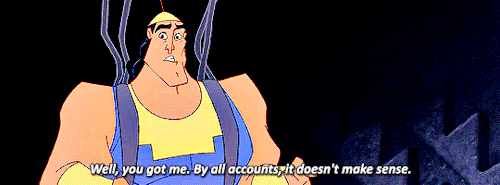
Finally, the notorious use of Siegmund and Sieglinde as Renais’ Sacred Twins. In all honesty, they were probably only used because those two characters are twins in Norse mythology, nothing more. I’ve seen claims that the incest between the twins at one point in the legends is “proof” that Eirika/Ephraim is basically canon, but said “evidence” runs into problems.
The first issue is the fact Siegmund and Sieglinde in-game have zero similarities to their legendary selves outside of their names. In lore, Siegmund used a sword, and there is no association with him to fire whatsoever. So how it becomes the Flame Lance in FE8 is a mystery. In fact, fire would be associated more with Sieglinde—who kills herself by burning to death with her husband, Siggeir, as penance for making Siegmund murder her own children and tricking him into an incestuous affair for the sake of revenge. Sieglinde in legend isn’t depicted using a weapon ever, and has absolutely no association with thunder. So her name being attached to the Thunder Sword came out of IntSys’ booty.
The second issue is the implication that the writers actually knew the contents of the legends they were referencing. If they knew what they were doing, they wouldn’t be using Excalibur, Latona, or Ivaldi. Considering that I just came up with my theory for Nidhogg, Vidofnir, Garm, and Audhulma, and there’s no actual in-game basis to suggest any of it, those names may as well have been picked out of a hat too. As mentioned above, IntSys completely made up the Flame Lance and Thunder Sword epithets, and they have no ties whatsoever to Sieglinde or Siegmund’s tale. So there’s no reason to assume that the writers knew, or cared about, any part of the legend outside of “they’re twins.”
Considering all the other Norse references in FE8, the reference to Siegmund and Sieglinde would also be rooted in Norse mythology more than Wagner’s Die Walküre. The Norse version of their story makes the incest a lot less consensual than Wagner’s version; Sieglinde tricks Siegmund into sleeping with her by disguising herself as someone else. Siegmund doesn’t find out until he and their son kill Siggeir. It is then that Sieglinde reveals the truth, and walks into the fire to burn to death as penance for her deeds. Then Siegmund goes and marries another woman. Oh, and before Sieglinde had her affair with Siegmund, she had Siegmund kill the “unworthy sons” she had with Siggeir since they didn’t prove themselves strong enough for the revenge she wanted. It’s because Siegmund refused to keep killing innocent children that she gets desperate enough to sleep with him. Eugenics, I guess. So the whole “Siegmund and Sieglinde are incestuous twins” thing is a lot more complicated than just that.
TL;DR: The names behind Magvel’s Sacred Twins basically have no connection to their namesakes at all.
29 notes
·
View notes
Text
Knights of the Round Table Official Tier List
God Tier:
Sir Ywain the Bastard: BFFs with a lion who may or may not have been able to talk. Very strong and ambitious without giving in to greed. Lost his sanity for a bit but sheer willpower brought it back, and mopped 0 seconds about it, went straight back to decimating ass in the name of justice and to save many numerous dames (honestly, if there was a dame in danger, this guy and his lion pal popped up immediately). Batman if his motif was the lion and also if Albert was a lion. Notable Feat: One of his adventures had him disenchant a cursed maiden who had been turned into a dragon by kissing her three times. That’s right, folks, Sir Ywain smooched dragon girls for reals and you’ll never achieve the heights of his glory.
Sir Percival the Grail Knight: Exceedingly powerful yet never once lorded his immense strength over anyone, and in fact, his impossibly humble nature actually had him act in ways to make others around him seem cooler, even though he was extremely capable. Clad in only a silk dress, Percival once threw a fully armored and armed knight over a castle wall, and this other time, clad in only shitty tin “armor” he made from pots, dddddestroyed an Evil Knight Of Certain Renown and stole his armor. The armor of pots happened because a merchant pulled a fast one over him (he traded his extremely expensive silk and gold-weave dress for a cart of junk), and then defended the man that fucked him over when the town was about to lynch him. Notable Feat: Defeated Sir Lancelot of the Lake (yes, that Lancelot) in fair and single combat, and kept disarming him instead of injuring him. Even then, he kept claiming “oh no, he won, I was just lucky, I am pretty sure he had the advantage” so as to not sully the hero’s name. Oh, yeah, and, you know, he fucking achieved the Holy Grail.
Sir Gawain: Dayman, Fighter of the Nightman, Champion of the Sun, You Are A Master of Karate, And Friendship For Everyone. Good man, very strong, was kind of a dumbass, but that adds to the charm. He’s the kind muscleman that spots for your scrawny ass in the gym your first time and tells you how to do the exercises properly. Most likely to become a good friend in the long term. Notable Feat: His whole fucking life, man. The code of chivalry didn’t actually apply to peasantry, as in, knights were not required to protect peasants at all, yet Gawain was known as the Defender of the Poor. What a fucking stud.
Galahad Tier:
Sir Galahad of Twilight: Galahad gets his own tier because he’s like some sort of Mary Sue that came outta nowhere in late transcriptions of Arthurian Mythos and sort of just was the best at everything ever in any context, which is funny because his father, Sir Lancelot, was more or less the same but actually likable (as in, Lancelot was not part of the original Old Welsh scriptures, and was basically really cool but also had a lot of flaws to his badassery, whereas Galahad is kinda just perfect). However, his divine protection does not allow me to put him at the bottom, for forces that dwarf my comprehension keep moving him up here. Notable Feat: Being a self-insert OC that got accepted in the canon.
Chivalrous Tier:
Sir Lancelot of the Lake: Goku, but lecherous. Notable Feat: Goku, but lecherous.
Sir Bedivere of the Perfect Sinews: The world’s first slot machine. Went on a ridiculous numbers of adventures in the early game, some of them even with Arthur’s dog, Cavall, and despite having only one arm, m dude was basically a Dynasty Warriors character. Openly practiced witchcraft, which almost got him hanged a couple of times, if it hadn’t been for Arthur’s interference and testimonies to his legitimately good character. Notable Feat: With Cavall the Dog, went on an adventure to kill an Evil Magical Boar and steal its comb, before hitting the boar so hard it fell right into the ocean and drowned, because Bedivere Don’t Fuck Around.
Sir Bors the Younger: Never on schedule, but always on time. Sir Bors wasn’t a superhuman like some of his peers, but his strong point was his virtue and how hard he adhered to the Code of Chivalry, which is more that can be said for a lot of knights, even in higher tiers. A hot young maiden once told him “FUCK WITH ME OR I WILL KILL MYSELF” but he refuse because he wouldn’t break his Vow of Celibacy. The girl, of course, turned out to be a DEMON that tried to trick him. Then, another time, his brother, Sir Lionel, was getting whipped by a notched whip by an assailant while a young girl was being kidnapped by a rogue knight. Notable Feat: He chose to save the young girl over his brother. His brother was Kinda Pissed, so he came back to murder Bors for abandoning him, and Bors didn’t defend himself, saying “yeah I understand why you are angry, honestly”. God himself saves Bors by striking down Lionel with a pillar of fire. Bors then went to be one of the three knights to achieve the Holy Grail (the other two being Percival and Galahad)
Sir Tristan (Or “Tristram” for you historians): Not only was Mister Sadman a capable fighter, Tristan also played instruments and sang, and he was said have a very beautiful voice. The beauty behind Tristan is that he went through multiple trials and tribulations that tested his worth as a person and as a Knight truly (as in, someone who pursues the path of chivalry) rather than his martial might. Notable Feat: Accidentally consumes a love potion with Iseult, who was on her way to marry someone, and he still held onto his reigns as a knight without betraying either chivalry or her love too much.
Manure Tier:
King Arthur: cuck. Notable Feat: His knights all went on way more exciting adventures than him and his peak is when he gets shanked by his illegitimate son and shanks him back and then spends like fourteen hours bitching at Bedivere for him to go drop his sword in a lake.
1K notes
·
View notes
Text
Sensor Sweep: Celtic Fantasy, Donald Wollheim, Creepy Magazine, Hideous Creatures
Popular Culture (Men of Violence): Historical fiction special! Vikings! Roman soldiers! Pirates! Swash-buckling soldiers of fortune!68 pages, all colour, packed with reproductions of rare and unusual paperbacks.Articles, reviews, interviews and features on Casca, Gardner Fox, Henry Treece, Talbot Mundy, Rosemary Sutcliff, Rafael Sabatini and forgotten cover artists.
Fiction (DMR Books): Awhile back, Dave Ritzlin here at the DMR blog asked me to recommend some good Celtic fantasy fiction. Today being Celtic New Year’s Day, it seemed appropriate to start off the New Year with a list of quality Celtic fiction.
To be honest, I can’t say that I like the vast majority of the fantasy which has been marketed or labeled as “Celtic.” As the late, great Steve Tompkins noted long, long ago, “cheapjack Celticism” has reigned o’er the land of Celtic fantasy since at least the 1980s. Languid, matriarchal tree-huggery tends to be the order of the day in most “Celtic” fiction, with the authors in question either being pig-ignorant of Celtic history and culture or cherry-picking to suit their (boring) take on the subject.
Fiction (DMR Books): Don Wollheim died on November 2, 1990, leaving behind him a sword and sorcery legacy that has never been matched. In the rarefied Valhalla of S&S editors/publishers, Wollheim sits enthroned at the high table. He debuted or “broke out”–as in, “their first big splash in the paperback market”–more enduring and important characters in the S&S
pantheon than any other editor/publisher. It is as simple as that.
Anime (Walker’s Retreat): Any Space Opera taking queues from Japan will not fail to acknowledge the Macross franchise. Starting in 1982 with Super Dimension Fortress Macross (which many of you known as the most popular part of Robotech), this is the #2 Real Robot franchise in Japan and has been since its debut (following the king that is Gundam). The consistent presence music as a power unto itself, the love triangles that drive the relationships, and their combination in the form of music that has now had inter-generational influence in anison and J-pop (and brought about the rise of Living Goddess Yoko Kanno).
Lovecraft and Gaming (Yog-Sothoth.com): My latest scrape of the internet reveals that Hideous Creatures: A Bestiary of the Cthulhu Mythos for Trail of Cthulhuhas been released. Kind of. Hideous Creatures… is officially on pre-order at Pelgrane’s web site, but an article comment reveals that you’ll receive the PDF as soon as you place the pre-order for the print edition. – That means it’s out. – The content is there for you to purchase and peruse now; the fact it’s digital bits rather than the 352 page hardback doesn’t alter the content (just the way it may be consumed). If you’re after a new bestiary of Cthulhoid creatures then have a look at Hideous Creatures… Pelgrane promises you something a little different.
Books (Atomic Junk Shop): Your Favorite Book Cover:
Oh my God that is an awful question for someone like me. I can’t decide. It really depends on the genre and the artist and what kind of mood I’m in that day. The best I can do is narrow it down to a few favorite artists. I think the artist that perfectly captured the spirit of the story more than anyone else is Gino d’Achille with his covers for the Edgar Rice Burroughs Mars books.
Fiction (Frontier Partisans): I was in the mood for some fun, for a read that strums the right chords but isn’t related to a project or anything that feels like work. That can be a problem for me. I tend to put way too much weight on my choices of fiction. Pondering this in preparation for Running Iron Report podcasts, I realized that I kind of expect a novel to rock my world, always seeking that visceral hit that I got when I was young and a novel would go to my head like strong wine. Chasing the high and most often finding myself dissatisfied.
It’s why I read very little fiction these days. I really don’t read just for funanymore. And that’s just stupid. I needed to get out of my own way and simply enjoy a yarn.
Over the weekend, I kept running across an author named Jonathan French and a book titled The Grey Bastards.
Comic Books (Paint Monk): Robert E. Howard is best known, and deservedly so, for Conan of Cimmeria, but he was a prolific author who wrote in several genres. While he arguably created the sword and sorcery tale, he also hammered out a staggering amount of pulp fiction, including westerns, boxing stories, detective yarns, and horror tales.
One of his best horror works was “Out of the Deep”, posthumously published in Magazine of Horror #18in their November 1967 issue.
Fiction (Tellers of Weird Tales): Before Spider-Man and Superman, before Marvel and DC, even before comic books, there was the word superhero. (1) My hypothesis is that the word and the concept originated in the 1890s, give or take a decade, just as so much of our popular culture originated at that time. In order to test my hypothesis, I have used an online search engine/database/index of newspapers dating to the nineteenth century. I can’t say that the newspaper articles I have found were actually the earliest occurrences in print of the following words. Even if they’re not, my guess is that they’re close, as ideas, concepts, and memes seem to arise at a certain time, often in a certain place, and in a certain society or culture.
Cinema (Sacnoth’s Scriptorium): John Boorman’s Lord of the Rings
In 1970, The Lord of the Rings was everywhere, its eco-friendly escapism dovetailing neatly with the communal mindset of the post-Woodstock era. A film was inevitable, and rights-holder United Artists turned to John Boorman, a British director with a passion for Arthurian fantasy and – more importantly – a moderate hit under his belt in Point Blank. Joining forces with the young screenwriter Rospo Pallenberg, Boorman turned out a script that covers all three books, runs to 178 pages and is, without question, one of the weirdest documents in existence.
Comic Books (Pulp Archivist): In 1947’s Writer’s Digest, Stan Lee, then editor of Timely Comics, writes in his “There’s Money in Comics”:
One point which I can’t stress too strongly is: DON’T WRITE DOWN TO YOUR READERS! It is common knowledge that a large portion of comic magazine readers are adults, and the rest of the readers who may be kids are generally pretty sharp characters.
Comic Books (Paint Monk): Few comics had the impact on me that Creepy did. The first issue I got my hands on was issue 4 of the magazine, dated August of 1965. I hadn’t even been born yet when this issue dropped, but I happened upon it at a flea market we used to visit when I was a kid and remember vividly seeing that Frank Frazetta cover for the first time.
Gaming (Niche Gamer): Publisher Skybound Games has announced they’ve cancelled the planned physical release of Hollow Knight.
The August-announced retail version of the game is now longer happening. Here’s a statement from Skybound:
“We are saddened to share that we’ll no longer be working with Team Cherry to bring Hollow Knight to new platforms. We absolutely love the game and wish Team Cherry continued success. We look forward to seeing what’s next for them.”
Here’s a rundown on the game:
Popular Culture (Kairos): Author JD Cowan offers a grim prognosis on the fate of pop culture based on Hollywood’s manifest inability to connect with its audience.
The Predator is a shallow, spiritually dead movie of stolen imagination and rehashed ideas with a message that could only have been thought up by someone too pathetic to grow up beyond adolescence. And it was written by someone who was there when the original film was being made. And not a talentless man, either. He wrote the original two (and best) Lethal Weapon films as well as Kiss Kiss Bang Bang. He knows action and how to give the audience what they want.
Sensor Sweep: Celtic Fantasy, Donald Wollheim, Creepy Magazine, Hideous Creatures published first on https://medium.com/@ReloadedPCGames
0 notes